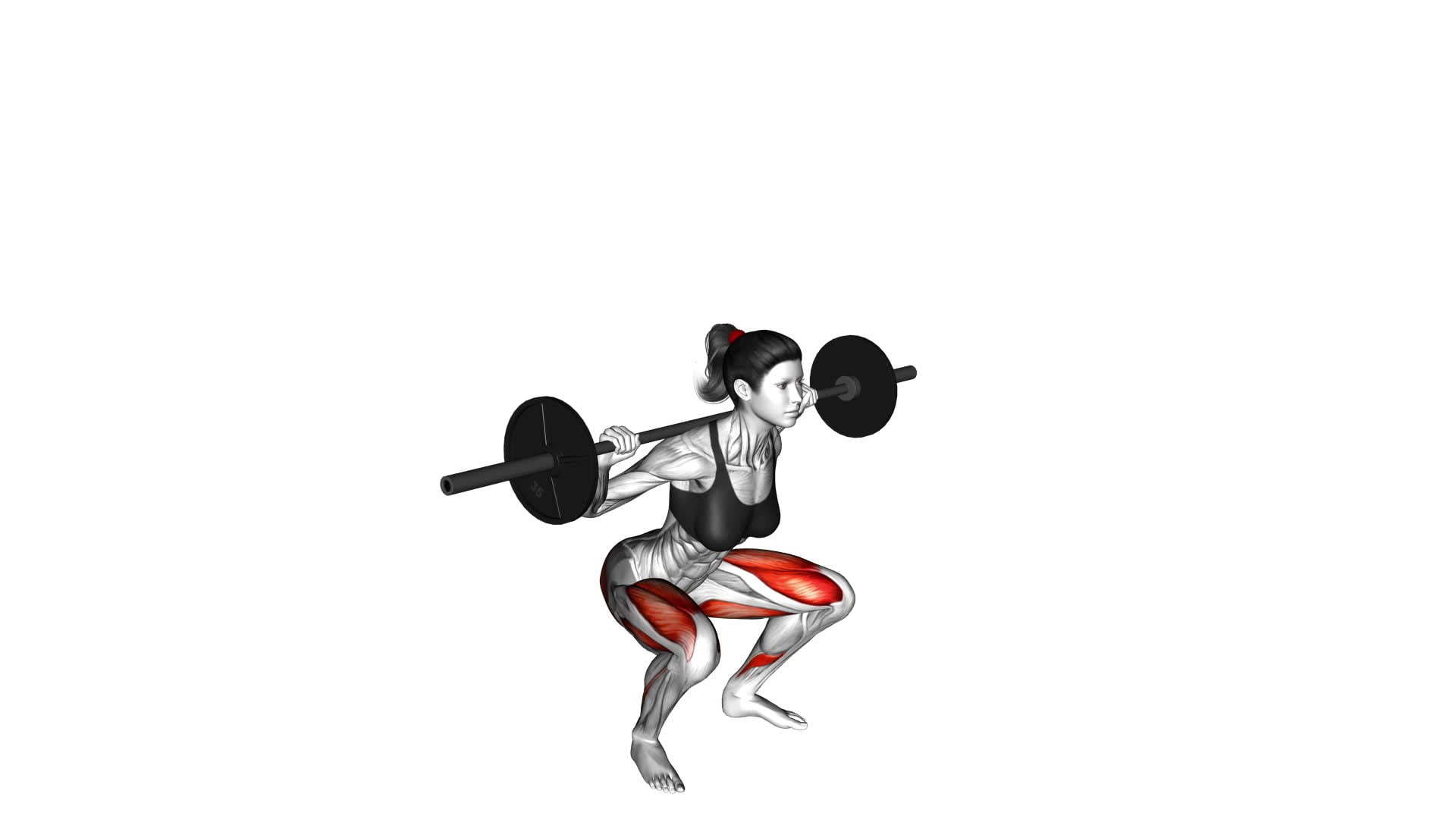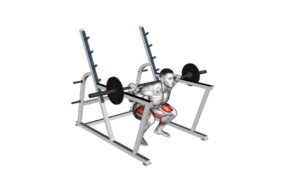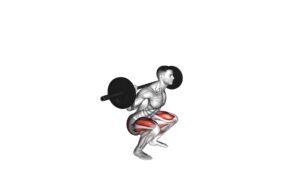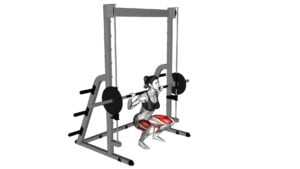Barbell Low Bar Squat (female) – Video Exercise Guide & Tips

Are you looking to strengthen your lower body and improve your overall fitness?
Watch This Exercise Video
Then the barbell low bar squat is the perfect exercise for you.
In this video exercise guide, you'll learn the proper technique, common mistakes to avoid, and variations to keep challenging yourself.
With our expert tips, you'll be able to incorporate the barbell low bar squat into your workout routine and see amazing results.
Get ready to squat your way to a stronger, fitter you!
Key Takeaways
- Barbell Low Bar Squat targets multiple muscle groups simultaneously, primarily focusing on quadriceps, hamstrings, and gluteal muscles.
- Engaging the core muscles during the squat exercise helps improve stability and support.
- Barbell Low Bar Squat helps in improving lower body strength, power, and muscle tone for females.
- Proper form and technique are essential to avoid common mistakes such as knee caving, rounding the back, and leaning too far forward, which can lead to injury.
Benefits of Barbell Low Bar Squat for Females
To maximize your strength training routine, incorporate the barbell low bar squat into your workouts as it offers numerous benefits for females. The importance of this exercise lies in its ability to target multiple muscle groups simultaneously, making it a highly efficient movement. The barbell low bar squat primarily targets the quadriceps, hamstrings, and gluteal muscles, helping to develop strength and definition in these areas. Additionally, it engages the core muscles, providing stability and support during the movement. By incorporating this exercise into your routine, you can expect to see improvements in lower body strength, power, and overall muscle tone.
Furthermore, the barbell low bar squat offers unique benefits for females. Due to anatomical differences, women tend to have a lower center of gravity and a wider pelvis compared to men. This makes the low bar squat particularly advantageous for females, as it allows for a more stable and balanced movement pattern. It also helps to strengthen the muscles surrounding the knees, reducing the risk of injury, especially common among women.
Proper Technique for Barbell Low Bar Squat
To perform the barbell low bar squat with proper technique, you should position the barbell across your upper back and shoulders. This exercise is highly effective for building lower body strength and can be a great addition to your workout routine. Here are some key points to keep in mind when performing the barbell low bar squat:
- Keep your feet shoulder-width apart and toes slightly turned out.
- Engage your core and keep your chest lifted throughout the movement.
- Descend by pushing your hips back and bending your knees, keeping your weight on your heels.
- Aim to lower yourself until your thighs are parallel to the ground, or slightly below if you have the flexibility.
- Drive through your heels as you push yourself back up to the starting position.
Now, let's discuss some common mistakes to avoid when performing the barbell low bar squat:
- Allowing your knees to cave inward.
- Rounding your back or hunching your shoulders.
- Leaning too far forward, which puts excessive strain on your lower back.
- Not going low enough or stopping short of the proper depth.
- Using too much weight and sacrificing proper form.
Common Mistakes to Avoid During Barbell Low Bar Squat
Avoid these five common mistakes when performing the barbell low bar squat to ensure proper form and maximize your results.
- Poor hip hinge: One of the most common mistakes isn't properly hinging at the hips. This can lead to excessive forward lean and strain on the lower back. To avoid this, focus on pushing your hips back as you lower into the squat, keeping your back straight and chest up.
- Knees caving in: Allowing your knees to cave inwards is a common form error that can put unnecessary stress on the knees and increase the risk of injury. To fix this, actively push your knees outwards throughout the entire movement, engaging your glutes and external hip rotators.
- Shallow squat depth: Failing to reach proper depth in your squat can limit the effectiveness of the exercise. Aim to lower your hips below parallel, ensuring that your thighs are parallel to the ground. This will engage your glutes and quads more effectively.
- Improper bar placement: Placing the bar too high on your back can cause excessive strain on your neck and shoulders. Make sure the bar is positioned on the shelf created by your rear deltoids and not resting on your neck.
- Lack of core engagement: Neglecting to engage your core during the squat can lead to instability and poor form. Prioritize bracing your core muscles throughout the movement to maintain proper alignment and support your spine.
Variations and Progressions for Barbell Low Bar Squat
As you progress in your barbell low bar squat journey, there are various variations and progressions you can incorporate to challenge yourself and continue making gains. Here are some advanced modifications and accessory exercises that you can add to your routine:
- Pause Squats: Pause at the bottom of your squat for a few seconds before driving back up. This helps to improve your strength and stability in the bottom position.
- Front Squats: Place the barbell in front of your body, resting on your shoulders. This variation targets your quads more and requires greater core stability.
- Box Squats: Set up a box or bench behind you and squat down until your glutes touch the surface. Pause briefly before standing back up. This variation helps to improve your explosiveness and control.
- Bulgarian Split Squats: Elevate one foot behind you on a bench or step, and perform a squat with your other leg. This exercise focuses on single-leg strength and stability.
- Barbell Lunges: Hold a barbell across your upper back and lunge forward with one leg at a time. This variation targets your quads, glutes, and hamstrings.
Incorporating these advanced modifications and accessory exercises into your barbell low bar squat routine won't only challenge your muscles in different ways but also help to improve your overall strength and stability.
Now, let's move on to the next section to learn some tips for incorporating barbell low bar squat into your workout routine.
Tips for Incorporating Barbell Low Bar Squat Into Your Workout Routine
How can you effectively incorporate the barbell low bar squat into your workout routine?
The barbell low bar squat is a compound exercise that targets multiple muscles in your lower body, making it an excellent choice for building lower body strength. Here are some tips to help you incorporate this exercise into your routine.
First, start by incorporating weights gradually. Begin with a weight that you can comfortably lift for 8-10 repetitions. As you become more comfortable and stronger, gradually increase the weight to continue challenging your muscles.
Next, make sure you have proper form and technique. Place the barbell across your upper back, resting it just below the base of your neck. Keep your feet shoulder-width apart and toes slightly pointed outwards. Lower your body by bending your knees and pushing your hips back, as if you're sitting back into a chair. Keep your chest up and your back straight throughout the movement.
To maximize the benefits of the barbell low bar squat, aim to perform it at least twice a week. You can include it as part of a leg day workout or incorporate it into a full-body routine. Remember to give your body ample rest between sessions to allow for muscle recovery and growth.
Incorporating the barbell low bar squat into your workout routine is a great way to build lower body strength. By gradually increasing the weight, maintaining proper form, and including it in your weekly routine, you'll be on your way to achieving stronger, more muscular legs.
Frequently Asked Questions
What Is the Recommended Weight Range for Females When Performing the Barbell Low Bar Squat?
When it comes to the recommended weight range for females doing the low bar squat, it's important to find a weight that challenges you but still allows for proper form.
The benefits of the low bar squat include strengthening your lower body muscles, improving your overall stability, and increasing your squatting power.
It's always a good idea to start with a weight that you can comfortably handle and gradually increase as you get stronger.
Can the Barbell Low Bar Squat Help Improve Posture and Core Strength?
The barbell low bar squat can definitely help improve your posture and core strength. By performing this exercise, you engage your core muscles, which in turn strengthens them and improves your overall stability.
Additionally, the squatting motion helps to promote better posture by strengthening the muscles that support your spine. So, incorporating the barbell low bar squat into your routine can have great benefits for both your posture and core strength.
Are There Any Specific Warm-Up Exercises That Should Be Done Before Performing the Barbell Low Bar Squat?
Before performing the barbell low bar squat, it's important to do specific warm-up exercises to prepare your muscles and joints.
These exercises can include dynamic stretches, such as leg swings and hip circles, as well as activation exercises for your glutes and core, like glute bridges and planks.
These warm-up exercises help increase flexibility, improve range of motion, and activate the muscles needed for a successful low bar squat.
How Often Should Females Incorporate the Barbell Low Bar Squat Into Their Workout Routine?
To maximize the benefits of the barbell low bar squat in your workout routine, it's important to incorporate it regularly. By including this exercise, you can strengthen your lower body and core muscles while improving overall stability.
To progress and increase the weight, start with a comfortable load and gradually add more weight as you become stronger and more confident in your form. This will help you continue challenging yourself and seeing progress in your fitness journey.
Are There Any Modifications or Alternatives to the Barbell Low Bar Squat for Females With Knee or Lower Back Issues?
If you're a female with knee or lower back issues, there are modifications and alternatives you can try instead of the barbell low bar squat.
For knee issues, you can try doing goblet squats with a kettlebell or using a resistance band for added support.
If you have lower back issues, you can opt for front squats or box squats to reduce strain on your back.
Remember to consult with a fitness professional to ensure proper form and technique.
Conclusion
In conclusion, the barbell low bar squat is a highly effective exercise for females, offering numerous benefits such as increased lower body strength and muscle development.
By following the proper technique and avoiding common mistakes, you can maximize the effectiveness of this exercise. Additionally, incorporating variations and progressions can help you continue challenging your muscles and seeing progress over time.
Remember to consult with a fitness professional for personalized guidance and ensure proper form and safety during your workouts.

Author
Years ago, the spark of my life’s passion ignited in my mind the moment I stepped into the local gym for the first time. The inaugural bead of perspiration, the initial endeavor, the very first surge of endorphins, and a sense of pride that washed over me post-workout marked the beginning of my deep-seated interest in strength sports, fitness, and sports nutrition. This very curiosity blossomed rapidly into a profound fascination, propelling me to earn a Master’s degree in Physical Education from the Academy of Physical Education in Krakow, followed by a Sports Manager diploma from the Jagiellonian University. My journey of growth led me to gain more specialized qualifications, such as being a certified personal trainer with a focus on sports dietetics, a lifeguard, and an instructor for wellness and corrective gymnastics. Theoretical knowledge paired seamlessly with practical experience, reinforcing my belief that the transformation of individuals under my guidance was also a reflection of my personal growth. This belief holds true even today. Each day, I strive to push the boundaries and explore new realms. These realms gently elevate me to greater heights. The unique combination of passion for my field and the continuous quest for growth fuels my drive to break new ground.







